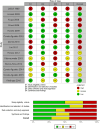Diagnosis or prognosis? An umbrella review of mid-trimester cervical length and spontaneous preterm birth
- PMID: 36871557
- PMCID: PMC10953024
- DOI: 10.1111/1471-0528.17443
Diagnosis or prognosis? An umbrella review of mid-trimester cervical length and spontaneous preterm birth
Abstract
Background: Cervical length is widely used to assess a woman's risk of spontaneous preterm birth (SPTB).
Objectives: To summarise and critically appraise the evidence from systematic reviews on the prognostic capacity of transvaginal sonographic cervical length in the second trimester in asymptomatic women with singleton or twin pregnancy.
Search strategy: Searches were performed in Medline, Embase, CINAHL and grey literature from 1 January 1995 to 6 July 2021, including keywords 'cervical length', 'preterm birth', 'obstetric labour, premature', 'review' and others, without language restriction.
Selection criteria: We included systematic reviews including women who did not receive treatments to reduce SPTB risk.
Data collection and analysis: From 2472 articles, 14 systematic reviews were included. Summary statistics were independently extracted by two reviewers, tabulated and analysed descriptively. The ROBIS tool was used to evaluate risk of bias of included systematic reviews.
Main results: Twelve reviews performed meta-analyses: two were reported as systematic reviews of prognostic factor studies, ten used diagnostic test accuracy methodology. Ten systematic reviews were at high or unclear risk of bias. Meta-analyses reported up to 80 combinations of cervical length, gestational age at measurement and definition of preterm birth. Cervical length was consistently associated with SPTB, with a likelihood ratio for a positive test of 1.70-142.
Conclusions: The ability of cervical length to predict SPTB is a prognostic research question; systematic reviews typically analysed diagnostic test accuracy. Individual participant data meta-analysis using prognostic factor research methods is recommended to better quantify how well transvaginal ultrasonographic cervical length can predict SPTB.
Keywords: cervical length; preterm birth; prognosis; systematic review; ultrasonography.
© 2023 The Authors. BJOG: An International Journal of Obstetrics and Gynaecology published by John Wiley & Sons Ltd.
Conflict of interest statement
BWM is supported by an NHMRC Practitioner Fellowship (GNT1082548) and reports a consultancy for ObsEva, Merck Merck KGaA, and Guerbet. Completed disclosure of interests form available to view online as supporting information.
Figures
Comment in
-
Prognostic research methodology: Tools to help predict the future.BJOG. 2023 Jul;130(8):880. doi: 10.1111/1471-0528.17459. Epub 2023 Apr 3. BJOG. 2023. PMID: 37264769 No abstract available.
Similar articles
-
Transvaginal sonographic measurement of cervical length to predict preterm birth in asymptomatic women at increased risk: a systematic review.Ultrasound Obstet Gynecol. 2008 May;31(5):579-87. doi: 10.1002/uog.5323. Ultrasound Obstet Gynecol. 2008. PMID: 18412093 Review.
-
Cervical assessment by ultrasound for preventing preterm delivery.Cochrane Database Syst Rev. 2019 Sep 25;9(9):CD007235. doi: 10.1002/14651858.CD007235.pub4. Cochrane Database Syst Rev. 2019. PMID: 31553800 Free PMC article.
-
Longitudinal evaluation of cervical length and shear wave elastography in women with spontaneous preterm birth.Ultrasound Obstet Gynecol. 2024 Jun;63(6):789-797. doi: 10.1002/uog.27614. Ultrasound Obstet Gynecol. 2024. PMID: 38354177
-
Second-trimester transvaginal ultrasound measurement of cervical length for prediction of preterm birth: a blinded prospective multicentre diagnostic accuracy study.BJOG. 2021 Jan;128(2):195-206. doi: 10.1111/1471-0528.16519. Epub 2020 Oct 19. BJOG. 2021. PMID: 32964581 Free PMC article.
-
First-trimester and early-second-trimester transvaginal cervical length before 16 weeks among women with preterm and term birth: a systematic review and meta-analysis.Am J Obstet Gynecol MFM. 2024 May;6(5S):101282. doi: 10.1016/j.ajogmf.2024.101282. Epub 2024 Jan 17. Am J Obstet Gynecol MFM. 2024. PMID: 38242499 Review.
Cited by
-
Primary prevention with vaginal chlorhexidine before 16 weeks reduces the incidence of preterm birth: results of the Preterm Labor Prevention Using Vaginal Antiseptics study.AJOG Glob Rep. 2023 Oct 16;3(4):100277. doi: 10.1016/j.xagr.2023.100277. eCollection 2023 Nov. AJOG Glob Rep. 2023. PMID: 38107249 Free PMC article.
-
Serum calcium level at 32 weeks of gestation could be applied as a predictor of preterm delivery: a retrospective study.Eur J Med Res. 2024 Aug 1;29(1):400. doi: 10.1186/s40001-024-01984-4. Eur J Med Res. 2024. PMID: 39090755 Free PMC article.
-
Evaluating the Efficacy of Cervical Tactile Ultrasound Technique as a Predictive Tool for Spontaneous Preterm Birth.Open J Obstet Gynecol. 2024 May;14(5):832-846. doi: 10.4236/ojog.2024.145067. Epub 2024 May 24. Open J Obstet Gynecol. 2024. PMID: 38845755 Free PMC article.
References
-
- UN Inter‐agency Group for Child Mortality Estimation , UNICEF , WHO , The World Bank , United Nations DoEaSA, Population Division , Division UNECfLAatCP . Levels & trends in child mortality: report 2012: IGME. 2012. 32 p.
-
- Natarajan GMD, Shankaran SMD. Short‐ and long‐term outcomes of moderate and late preterm infants. Am J Perinatol. 2016;33(3):305–17. - PubMed
-
- Mericq V, Martinez‐Aguayo A, Uauy R, Iniguez G, Van der Steen M, Hokken‐Koelega A. Long‐term metabolic risk among children born premature or small for gestational age. Nat Rev Endocrinol. 2017;13(1):50–62. - PubMed
-
- Michaels WH, Montgomery C, Karo J, Temple J, Ager J, Olson J. Ultrasound differentiation of the competent from the incompetent cervix – prevention of preterm delivery. Am J Obstet Gynecol. 1986;154(3):537–46. - PubMed
Publication types
MeSH terms
Grants and funding
LinkOut - more resources
Full Text Sources



